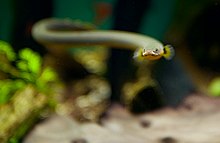
Cichlids are fish from the family Cichlidae in the order Cichliformes. Traditionally Cichlids were classed in a suborder, the Labroidei, along with the wrasses (Labridae), in the order Perciformes, but molecular studies have contradicted this grouping. On the basis of fossil evidence, it first appeared in Tanzania during the Eocene epoch, about 46–45 million years ago. The closest living relative of cichlids is probably the convict blenny, and both families are classified in the 5th edition of Fishes of the World as the two families in the Cichliformes, part of the subseries Ovalentaria. This family is large, diverse, and widely dispersed. At least 1,650 species have been scientifically described, making it one of the largest vertebrate families. New species are discovered annually, and many species remain undescribed. The actual number of species is therefore unknown, with estimates varying between 2,000 and 3,000.
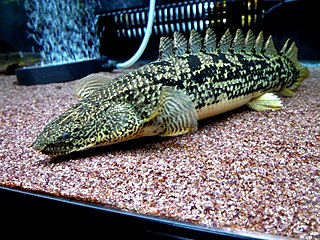
Bichirs and the reedfish comprise Polypteridae, a family of archaic ray-finned fishes and the only family in the order Polypteriformes.

The cardinal tetra is a freshwater fish of the family Characidae of order Characiformes. It is native to the upper Orinoco and Negro Rivers in South America. Growing to about 3 cm (1.2 in) total length, the cardinal tetra has the striking iridescent blue line characteristic of the genus Paracheirodon laterally bisecting the fish, with the body below this line being vivid red in color, hence the name "cardinal tetra". The cardinal tetra's appearance is similar to that of the closely related neon tetra, with which it is often confused; the neon's red coloration extends only about halfway to the nose, and the neon's blue stripe is a less vibrant blue.

The giant danio is a tropical fish belonging to the minnow family Cyprinidae. Originating in Sri Lanka, Nepal, and the west coast of India, this species grows to a maximum length of 4–6 inches (10–15 cm), making it one of the largest of the danionins. It is characterized by a blue and yellow, torpedo-shaped body with gray and clear fins.

Polypterus senegalus, the Senegal bichir, gray bichir or Cuvier's bichir, and sometimes called the "dinosaur eel", "dinosaur bichir", or "dragon fish" is in the pet trade due to its lungfish-like appearance, which was described as more primitive and prehistoric than other modern fishes. It is a prototypical species of fish in the genus Polypterus, meaning most of its features are held across the genus. It is commonly kept in captivity by hobbyists. They are native from Africa where they are the most widespread species of the genus.
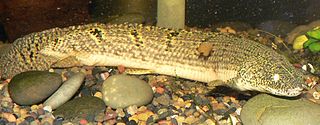
Polypterus is a genus of freshwater fish in the bichir family (Polypteridae) of order Polypteriformes. The type species is the Nile bichir. Fish in this genus live in various areas in Africa. Polypterus is the only known vertebrate to have lungs, but no trachea.
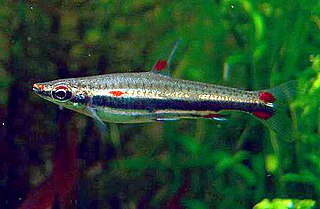
Nannostomus trifasciatus,, commonly known as the three-lined or three-stripe pencilfish, is a freshwater species of fish belonging to the characin family Lebiasinidae. They are popular in the aquarium trade due to their small size, beautiful color pattern, and relative hardiness.

Polypterus bichir lapradei is a subspecies of freshwater fish in the family Polypteridae. P. bichir lapradei are demersal, primitive, and popular with experienced aquarists.

Polypterus ornatipinnis, the ornate bichir, is a bony fish found in Lake Tanganyika and the Congo River basin in Central and East Africa.

The barred bichir, armoured bichir, bandback bichir, or banded bichir is an elongated fish found in the Congo River, specifically in the upper and middle portions. This species is one of the more commonly available in commercial pet stores.
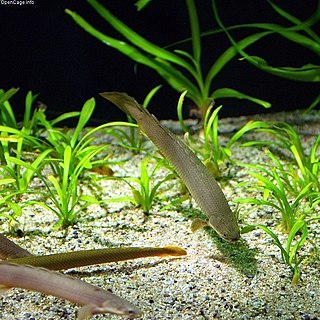
Cladistia is a clade of bony fishes whose only living members are the bichirs of tropical Africa. Their major synapomorphies are a heterocercal tail in which the dorsal fin has independent rays, and a posteriorly elongated parasphenoid.

The saddled bichir, Polypterus endlicheri endlicheri, is a prototypical subspecies of the Polypterus genus, meaning most of its features are held across the genus.

Polypterus endlicheri, the saddled bichir, is one of the largest species of the Polypterus genus of freshwater fish.
Polypterus congicus, the Congo bichir, is a species of bichir with a maximum recorded size of 970 millimetres (38 in). The colour also varies from yellowish brown to grey, darker in the top, paler in the ventral area. It has a pattern of around 8 irregular vertical bands along the flanks of the fish, that do not extend completely onto the ventral surface. The lower jaw is prominent, much like Polypterus endlicheri. The male has a wider and thicker anal fin. These fish are commonly sold as pets.

Polypterus palmas, also called the shortfin or marbled bichir, is a fish in the family Polypteridae found in freshwater environments throughout West Africa.
The West African bichir or retropinnis bichir, is a freshwater fish in the family Polypteridae, is found in the central Congo River basin and Ogooué River in Africa. It is a long, slender fish that grows to a maximum length of about 34 cm (13 in).
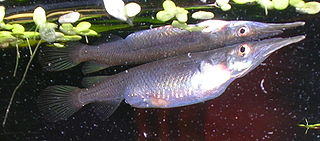
Zenarchopteridae, the viviparous halfbeaks, is a family in the order Beloniformes. The Zenarchopteridae exhibit strong sexual dimorphism, practicing internal fertilisation, and in some cases ovoviviparous or viviparous. The members in the family are mainly found in fresh and brackish water of tropical Asia and New Guinea, but the genus Zenarchopterus also includes marine species from the Indo-Pacific. Several, such as the wrestling halfbeak, have become commonly traded aquarium fish.
Polypterus teugelsi is a species of carnivorous, nocturnal bichir that lives in the Cross River drainage basin in the country of Cameroon. P. teugelsi was described in 2004 by Ralf Britz.
Polypterus mokelembembe is a species of the fish genus Polypterus, found in the central basin of the Congo River. It was once considered a morph of the closely related Polypterus retropinnis, but was given species status in 2006 with a description that reclassified both fishes. Because of the recency of the species' description and the fact that P. mokelembembe is the paralectotype of P. retropinnis, they are often mistaken for one another in the aquarium trade.
Polypterus polli, Poll's bichir, is a species of bichir from the Malebo Pool and the lower and central basins of the Congo River. It was named in honor of Belgian ichthyologist Max Poll.
